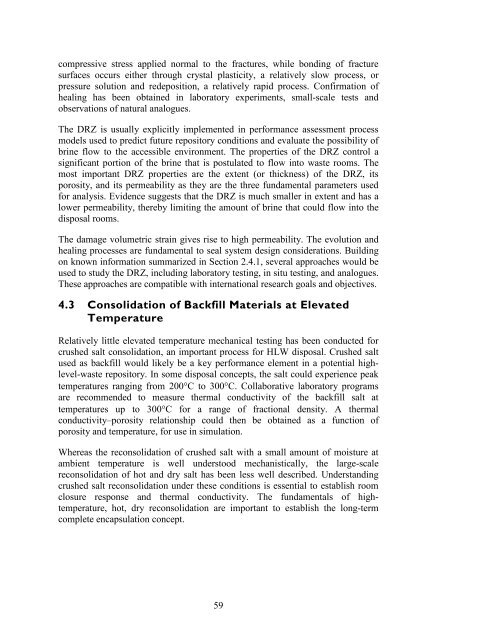Salt Disposal of Heat-Generating Nuclear Waste
Salt Disposal of Heat-Generating Nuclear Waste
Salt Disposal of Heat-Generating Nuclear Waste
You also want an ePaper? Increase the reach of your titles
YUMPU automatically turns print PDFs into web optimized ePapers that Google loves.
compressive stress applied normal to the fractures, while bonding <strong>of</strong> fracture<br />
surfaces occurs either through crystal plasticity, a relatively slow process, or<br />
pressure solution and redeposition, a relatively rapid process. Confirmation <strong>of</strong><br />
healing has been obtained in laboratory experiments, small-scale tests and<br />
observations <strong>of</strong> natural analogues.<br />
The DRZ is usually explicitly implemented in performance assessment process<br />
models used to predict future repository conditions and evaluate the possibility <strong>of</strong><br />
brine flow to the accessible environment. The properties <strong>of</strong> the DRZ control a<br />
significant portion <strong>of</strong> the brine that is postulated to flow into waste rooms. The<br />
most important DRZ properties are the extent (or thickness) <strong>of</strong> the DRZ, its<br />
porosity, and its permeability as they are the three fundamental parameters used<br />
for analysis. Evidence suggests that the DRZ is much smaller in extent and has a<br />
lower permeability, thereby limiting the amount <strong>of</strong> brine that could flow into the<br />
disposal rooms.<br />
The damage volumetric strain gives rise to high permeability. The evolution and<br />
healing processes are fundamental to seal system design considerations. Building<br />
on known information summarized in Section 2.4.1, several approaches would be<br />
used to study the DRZ, including laboratory testing, in situ testing, and analogues.<br />
These approaches are compatible with international research goals and objectives.<br />
4.3 Consolidation <strong>of</strong> Backfill Materials at Elevated<br />
Temperature<br />
Relatively little elevated temperature mechanical testing has been conducted for<br />
crushed salt consolidation, an important process for HLW disposal. Crushed salt<br />
used as backfill would likely be a key performance element in a potential highlevel-waste<br />
repository. In some disposal concepts, the salt could experience peak<br />
temperatures ranging from 200°C to 300°C. Collaborative laboratory programs<br />
are recommended to measure thermal conductivity <strong>of</strong> the backfill salt at<br />
temperatures up to 300°C for a range <strong>of</strong> fractional density. A thermal<br />
conductivity–porosity relationship could then be obtained as a function <strong>of</strong><br />
porosity and temperature, for use in simulation.<br />
Whereas the reconsolidation <strong>of</strong> crushed salt with a small amount <strong>of</strong> moisture at<br />
ambient temperature is well understood mechanistically, the large-scale<br />
reconsolidation <strong>of</strong> hot and dry salt has been less well described. Understanding<br />
crushed salt reconsolidation under these conditions is essential to establish room<br />
closure response and thermal conductivity. The fundamentals <strong>of</strong> hightemperature,<br />
hot, dry reconsolidation are important to establish the long-term<br />
complete encapsulation concept.<br />
59
















